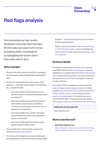BODS red flags analysis
Help us understand how you are making use of resources from the Open Ownership website by filling out this short survey
Publication type
Technical guidance
Publication
Topics
Beneficial Ownership Data Standard,
BODS showcase
Sections
Technology
Summary
Demonstrating how high-quality Beneficial Ownership Data Standard (BODS) data can support anti-money laundering (AML) investigations by highlighting risk factors which data users want to spot.
Aims of project
- Research the main questions that AML investigators want to answer, using just beneficial ownership (BO) data.
- See if Open Ownership (OO) could answer a list of questions – eventually reduced down to the following list – using BODS data:
- How many entities declare that they have no beneficial owners or that their beneficial owners are unknown?
- How many entities have ownership networks which involve natural persons or entities in countries on the European Union list of non-cooperative tax jurisdictions?
- How many entities have complex ownership chains (defined here as five-plus observable layers of ownership)?
- How many entities were founded and subsequently dissolved within a year?
- Demonstrate how to answer these questions by setting up a public data notebook.
- Do future work to explain how to answer these questions differently for Denmark, Slovakia, and the United Kingdom – and why this makes the case for further BO data standardisation.
- Build on past work creating notebooks/dashboards to test BODS data quality to show how BODS data can be used for a wide range of purposes (see Latvia test notebook).
Delivered in partnership with
Open Data Services

